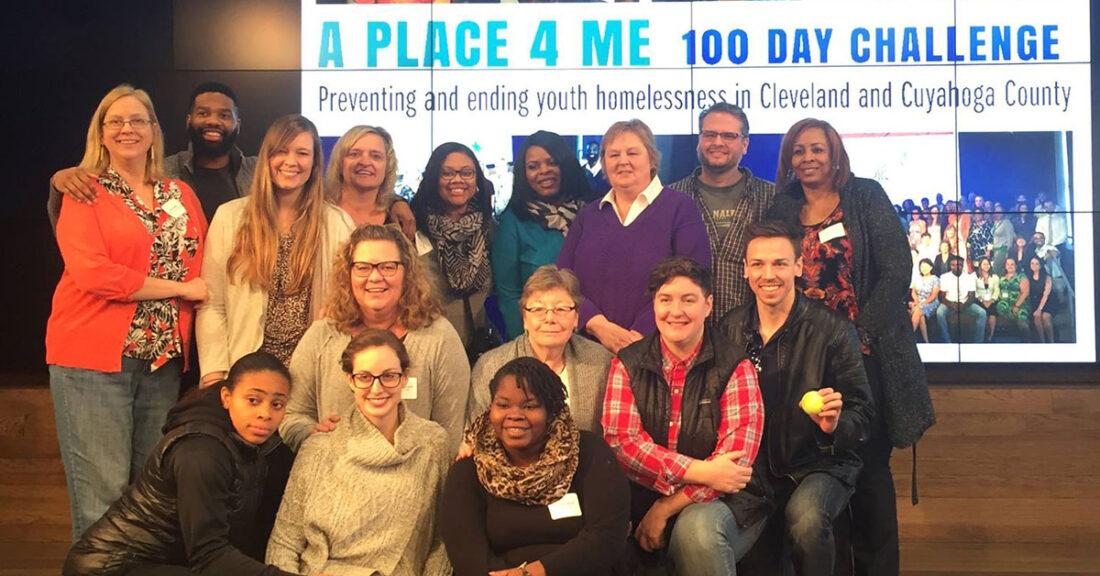Tackling Youth Homelessness With Peer Navigators in Cleveland

Two years ago, A Place 4 Me set out to house 100 youth in 100 days as part of its ongoing efforts to improve outcomes for transition-age youth in foster care. The initiative exceeded its goal and — in the process — showed how to strengthen support systems and services for young people in foster care.
Kate Lodge is the executive director and vice president of strategic initiatives at A Place 4 Me, which is the Annie E. Casey Foundation’s Cleveland-based partner in its Jim Casey Youth Opportunities Initiative® Network. In this post, Lodge describes how Cleveland had adopted innovative practices, such as the hiring of peer navigators, to tackle youth homelessness today.
You say you are ending youth homelessness versus reducing it. Why?
Lodge: It is a bold statement, but I think the bold statement is what sets a strong foundation for not only our desired result but also how we envision reaching it. We are putting the onus on ourselves to find new ways and new solutions to address the different problem areas that lead to homelessness. It’s really a call to action to recognize that this problem is unacceptable and to stress the point that every young person deserves to be stably housed.
How are peer navigators instrumental in this work?
Lodge: We have too many young people who leave shelters without information about where they are going next. After digging deeper into the data, A Place 4 Me secured grant funds to hire two peer navigators to provide peer-to-peer outreach and resource support to these youths. The two young folks currently in those roles have experience with both foster care and homelessness, and their efforts to connect with other young people in similar circumstances have proved helpful.
One of the peer navigators, Stefphon Kennedy, was in the community’s library one Friday night and saw a young man who he’s known for a long time. He tells him to come by and meet him on Monday because there’s talk of housing resources for which he’d be eligible. Because of that already established, trusted connection between the two men, Stefphon’s friend did come by that Monday and through us and our resources, he eventually moved into his own apartment a few months later.
This is just one of many examples that shows how critical these authentic relationships are for young people in this community. There’s a level of trust there that is already established in a way that is much harder to do with adult strangers coming at you with ideas for the next steps in your life.
Are there plans to expand the number of peer navigators?
Our goal is to hire more peer navigators to help engage youth in their transition planning and help connect them to services. Because trying to figure out the system can be intimidating, especially for a young person, the navigators can step in to create a level of trust. With this increase in navigators, we hope that the future homelessness numbers would begin to decrease and continue to stay low.
What other approaches have A Place 4 Me used to address the young adult homelessness problem in Cleveland?
To better address homelessness, you must first understand the scale of the issue. Tracking methods to identify individual demographics help us to not only see things on a more granular level but also find patterns that we can work toward addressing and eliminating.
Our primary tool, the By Name List, identifies every homeless youth and captures a variety of individual demographics that helps us track young people who come straight from foster care.
As of August 2019, this dashboard revealed that in Cleveland alone there were 233 active homeless youths — up from 190 in April. This included 52 new homeless folks and 16 others returning to homelessness. The inflow number of homeless youth is still far higher than we’d like to see it. So now we’re focusing on what we can do in the community to reduce that inflow number. What preventive opportunities do we have for these kids? How do we address that gap between exiting foster care and entering shelters?
So, while it’s great that we have these data available to us — especially since our work is grounded in data — the work then becomes about real-life solutions for real-life people and not just numbers. It’s asking: What policies can we implement to change the trajectory of young people exiting foster care so they don’t find themselves homeless without a plan?





